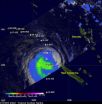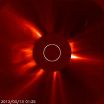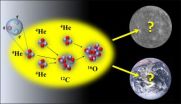(Press-News.org) NASA's Tropical Rainfall Measuring Mission satellite, also known as TRMM, flew over Cyclone Sandra twice in one day and noticed a large decrease in rainfall intensity over a nine hour period.
On March 11, 2013, NASA's TRMM satellite twice flew above weakening tropical cyclone Sandra as it was passing to the west of New Caledonia in the southern Pacific Ocean. TRMM's Precipitation Radar (PR) had a very good view of Sandra as it passed directly above the tropical cyclone on March 11 at 1312 UTC (9:12 a.m. EST). TRMM PR measured rainfall at the extreme rate of over 206 mm (~8 inches) per hour in an area southwest of Sandra's eye. Those TRMM PR data also showed that very little rain was occurring north of the weakening tropical cyclone's eye.
New Caledonia escaped the heaviest precipitation as the center of Sandra remained off-shore.
Later on that day at 2124 UTC (4:24 p.m. EDT), TRMM's Microwave Imager (TMI) data identified diminished rainfall rates. The heaviest rains occurring south of Sandra's center at that time was falling at a rate of 30 mm (1.18 in) per hour. Wind shear continues to increase from the north and push the precipitation south of Sandra's center. Sandra's center has since become fully exposed to outside winds as the intensity of rainfall has diminished.
VIDEO:
NASA's TRMM satellite data was used to create this 3-D flyby animation showing cloud heights and rainfall intensity on March 11. Cyclone Sandra's rainfall intensity was generally around 30 mm/1.18...
Click here for more information.
On Mar. 13 at 0300 UTC, Sandra's maximum sustained winds were near 55 knots (63.2 mph/101.9 kph). Sandra was located near 24.1 south and 161.5 east, about 270 nautical miles (310.7 miles/500 km ) west-southwest of Noumea, New Caledonia. Sandra was moving to the south-southwest at 8 knots (9.2 mph/14.8 kph).
Sandra is moving into an area of high vertical wind shear and colder sea surface temperatures that are expected to make the storm transform into a cold-core system before it dissipates over the next couple of days.
INFORMATION:
NASA sees large decrease in Cyclone Sandra's rainfall intensity
2013-03-14
ELSE PRESS RELEASES FROM THIS DATE:
Dwelling on stressful events can increase inflammation in the body, study finds
2013-03-14
ATHENS, Ohio (March 13, 2013)—Dwelling on negative events can increase levels of inflammation in the body, a new Ohio University study finds.
Researchers discovered that when study participants were asked to ruminate on a stressful incident, their levels of C-reactive protein, a marker of tissue inflammation, rose. The study is the first time to directly measure this effect in the body.
"Much of the past work has looked at this in non-experimental designs. Researchers have asked people to report their tendency to ruminate, and then looked to see if it connected to physiological ...
Scientists discover novel chemical that controls cell behavior
2013-03-14
March 12, 2013 — Albuquerque, NM (UNM Cancer Center) — It's the spread of the original cancer tumor that kills most people. That's why cancer researchers vigorously search for drugs that can prevent metastases, the spread of cancer. The research team co-led by Angela Wandinger-Ness, PhD, and Larry Sklar, PhD, at the University of New Mexico Cancer Center has found a chemical compound that appears to control cell migration and adhesion, two important characteristics of metastatic cancer cells. The team recently published a paper describing how the first-in-class compound ...
Sun spits out 2 CMEs
2013-03-14
The sun recently erupted with two coronal mass ejections (CMEs). One began at 8:36 p.m. EDT on March 12, 2013 and is directed toward three NASA spacecraft, Spitzer, Kepler and Epoxi. There is, however, no particle radiation associated with this event, which is what would normally concern operators of interplanetary spacecraft since the particles can trip computer electronics on board. A second CME began at 6:54 a.m. EDT on March 13, 2013 and its flank may pass by Earth at a speed that does not typically have a significant impact at Earth.
Experimental NASA research models, ...
Vitamin D may lower blood pressure in African-Americans
2013-03-14
Boston – High blood pressure, a risk factor for heart attacks, heart failure and stroke, is 40 percent more common in African-Americans than in other American ethnic groups. In a new study from Brigham and Women's Hospital (BWH), along with the Dana-Farber Cancer Institute and Massachusetts General Hospital, researchers show that vitamin D supplementation may help African-Americans lower their blood pressure. The study publishes online in the March 13, 2013 edition of the American Heart Association journal Hypertension.
"This study may explain and help treat an important ...
US lifespans lags other high-income countries, tied to mortality rates under age 50
2013-03-14
Higher mortality rates among Americans younger than 50 are responsible for much of why life expectancy is lower in the United States than most of the world's most developed nations.
The research, by Jessica Ho, a University of Pennsylvania doctoral candidate in demography and sociology, found that excess mortality among Americans younger than 50 accounted for two-thirds of the gap in life expectancy at birth between American males and their counterparts and two-fifths between females and their counterparts in the comparison countries.
The study, "Mortality Under Age ...
Foundations of carbon-based life leave little room for error
2013-03-14
Life as we know it is based upon the elements of carbon and oxygen. Now a team of physicists, including one from North Carolina State University, is looking at the conditions necessary to the formation of those two elements in the universe. They've found that when it comes to supporting life, the universe leaves very little margin for error.
Both carbon and oxygen are produced when helium burns inside of giant red stars. Carbon-12, an essential element we're all made of, can only form when three alpha particles, or helium-4 nuclei, combine in a very specific way. The ...
UI study of Midwest finds increase in heavy rainfalls over 60 years
2013-03-14
Heavy rains have become more frequent in the upper Midwest over the past 60 years, according to a study from the University of Iowa. The trend appears to hold true even with the current drought plaguing the region, the study's main author says.
The fact that temperatures over the country's midsection are rising, too, may be more than coincidence.The hotter the surface temperature, which has been the trend in the Midwest and the rest of the world, the more water that can be absorbed by the atmosphere. And the more water available for precipitation means a greater chance ...
Video game 'exercise' for an hour a day may enhance certain cognitive skills
2013-03-14
Playing video games for an hour each day can improve subsequent performance on cognitive tasks that use similar mental processes to those involved in the game, according to research published March 13 in the open access journal PLOS ONE by Adam Chie-Ming Oei and Michael Donald Patterson of Nanyang Technological University, Singapore.
Non-gamer participants played five different games on their smartphones for an hour a day, five days of the week for one month. Each participant was assigned one game. Some played games like Bejeweled where participants matched three identical ...
Series of studies first to examine acupuncture's mechanisms of action
2013-03-14
WASHINGTON — While acupuncture is used widely to treat chronic stress, the mechanism of action leading to reported health benefits are not understood. In a series of studies at Georgetown University Medical Center (GUMC), researchers are demonstrating how acupuncture can significantly reduce the stress hormone response in an animal model of chronic stress.
The latest study was published today in the April issue of Journal of Endocrinology.
"Many practitioners of acupuncture have observed that this ancient practice can reduce stress in their patients, but there is a ...
Brain stent offers alternative to shunt for fixing potentially blinding vein narrowing
2013-03-14
A team of interventional neuroradiologists and neurosurgeons at Johns Hopkins reports wide success with a new procedure to treat pseudotumor cerebri, a rare but potentially blinding condition marked by excessive pressure inside the skull, caused by a dangerous narrowing of a vein located at the base of the brain.
The Johns Hopkins team's latest study, to be published in the Journal of Neuro-Ophthalmology online March 14, is believed to be the first to show how directly lowering pressure inside the vein alleviates the condition and improves vision.
The study report on ...


